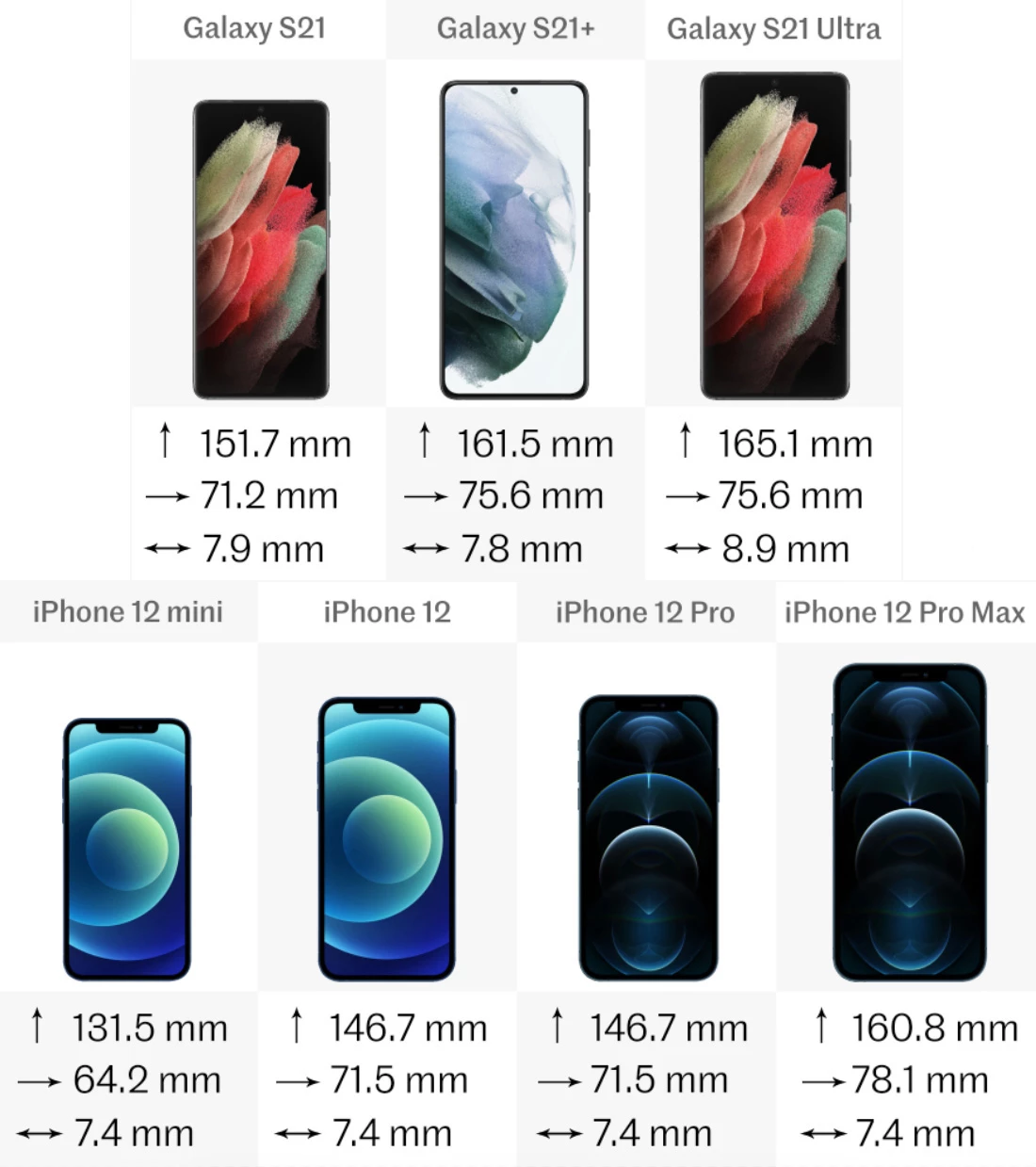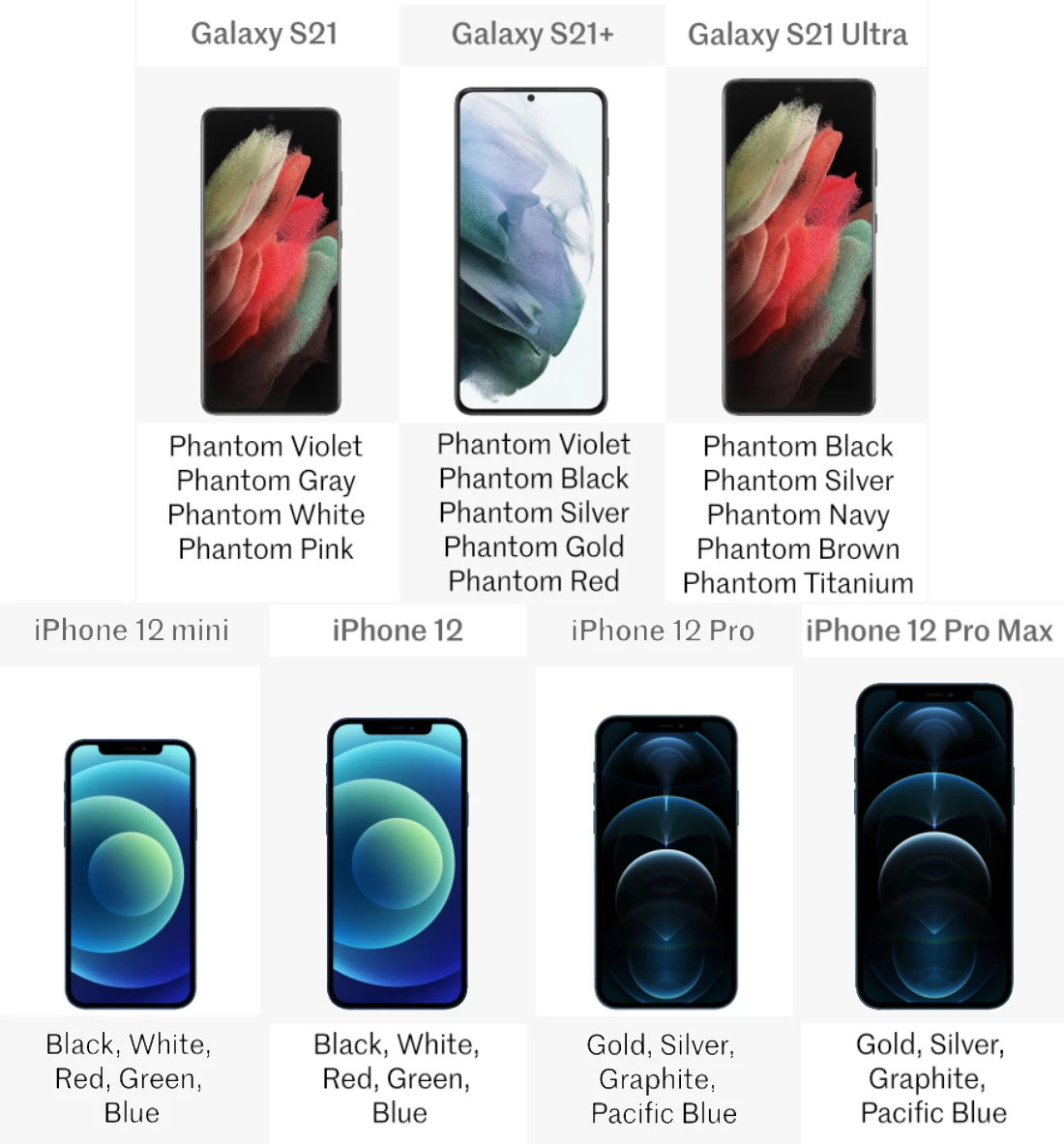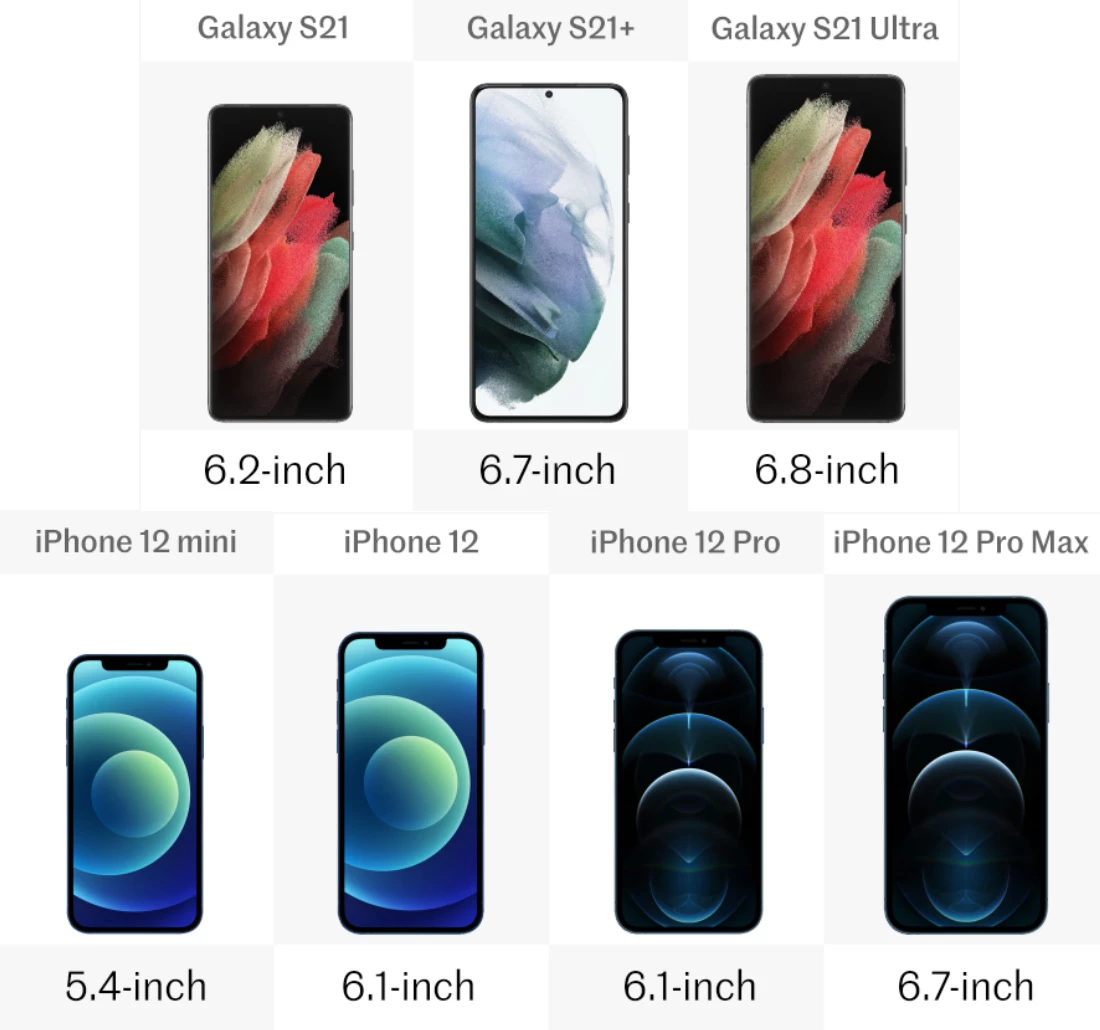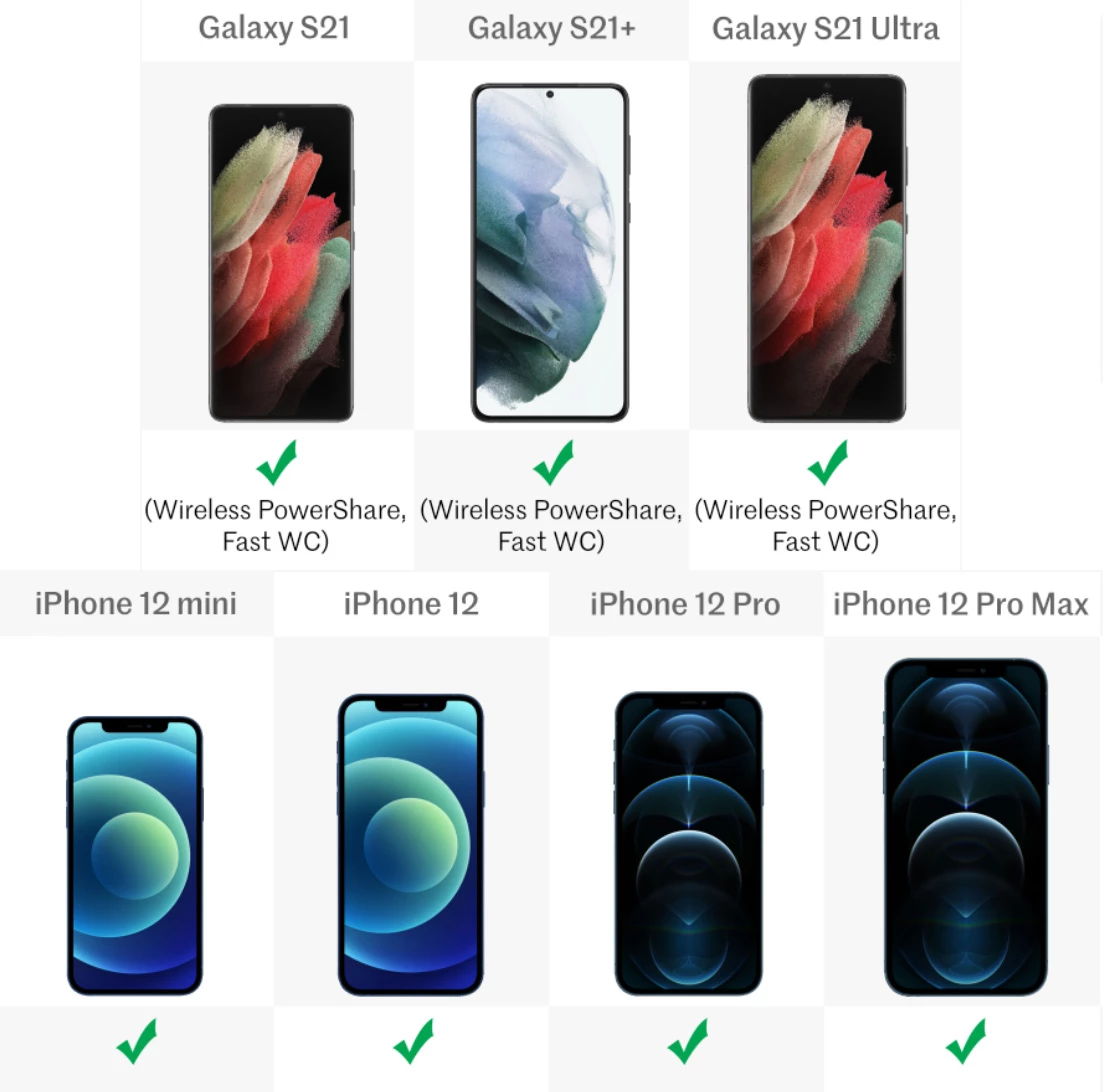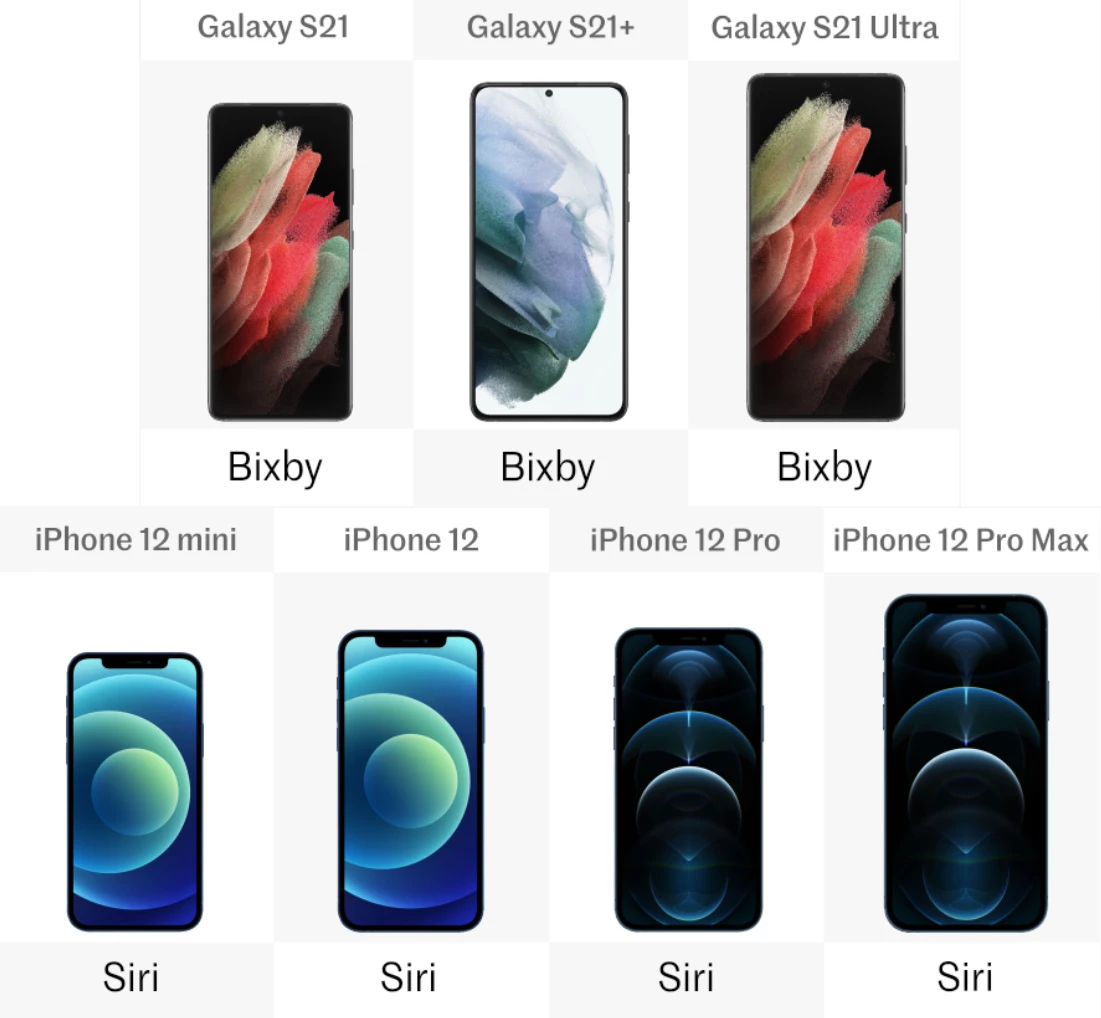The cycle of new phones never stops, and the first flagships for 2021 are already here – Samsung’s shiny new Galaxy S21 series. But how do they stack up against the latest from the industry-leading Apple? New Atlas compares the specs and features of the Galaxy S21, S21+ and S21 Ultra to the iPhone 12, 12 mini, 12 Pro and 12 Pro Max.
As usual, there are three new Galaxies, but this year Apple has decided to throw in a fourth iPhone (probably just to mess up our table here). The iPhone 12 mini is a budget model that’s surprisingly capable, and comparable in many ways to the Galaxy S21, so we’ve included it here. Besides that anomaly, the two lineups look similar – you’ve got the simple base model, the better-specced plus model and the over-the-top premium model. For both companies, the first two models are quite similar, with a much bigger gap to the premium model.Size

Generally, the Galaxies are bigger than the iPhones. Living up to its name, the iPhone 12 mini is the smallest of the bunch – and one of the smallest major phones around today – by quite a wide margin. After that, it’s a tie between the iPhone 12 and 12 Pro, which have the exact same body. The Galaxy S21 is a few millimeters taller than those two.
Then there’s a big gap that seems to separate the basic and premium models. The iPhone 12 Pro Max is almost 10 mm taller and 6 mm wider, followed closely by the Galaxy S21+, which is slightly taller again but a tad narrower.
And finally, the Galaxy S21 Ultra is the biggest of them all, stretching much taller and thicker – but still slightly narrower – than its Apple counterpart.Weight

Weight-wise, the phones follow more or less the same trajectory. For reference, a US nickel weighs exactly five grams, which should give you a rough idea of the equivalent pocketful of change you’d be carrying around with each of these phones.
For the Galaxies, there’s a two-gram difference depending on which 5G tech your model runs on – sub6 or mmWave (we’ll explain that later).Colors

Most of the usual colors are accounted for here, with blacks, whites, grays, silvers and golds aplenty.
The iPhone 12 and 12 mini come in bolder and brighter shells, while the 12 Pro and Pro Max go for classier, muted tones. It’s interesting to note that the 12 and 12 Pro are very similar in specs but not in price, and one of the few points of difference is that Apple apparently tried to polish the Pro with fancier colors.
The Galaxy lineup, meanwhile, comes in a range of pastel tones with a metallic finish, which Samsung tries to class up by describing them as “Phantom” for some reason.Build

All of these phones are made with glass front and back, with a metal frame. The only exception is the Galaxy S21, which has a plastic backing.
In the iPhone 12 Pro and Pro Max, the frame is stainless steel, while the rest of the phones are made with aluminum.
In the Samsung phones, that glass is Corning’s Gorilla Glass Victus, which can apparently withstand drops onto hard, rough surfaces from up to 2 m (6.6 ft). Apple uses a new protective coating that it calls Ceramic Shield, which apparently bestows its latest lineup with four times better “drop performance” than the iPhone 11.Display size

Most flagship phones have displays north of 6 inches nowadays, and that’s true across the board here – with the sole exception of the iPhone 12 mini, with its petite 5.4 in.
The iPhone 12 and 12 Pro both come in at 6.1 in – again making it hard to physically distinguish between the two models. The Galaxy S21 has a marginally bigger screen, at 6.2 in.
And then there’s the wide gap to the premium phones. The iPhone 12 Pro Max and Galaxy S21+ have 6.7-in displays, just pipped by the Galaxy S21 Ultra at a spacious 6.8 in.Screen-to-body ratio

With companies competing to cram as much screen onto the front of their devices as possible, bezels have gone the way of the dodo. In percentage figures, all of these phones are pretty close together in the high 80s.Display resolution

All seven of these phones have resolutions upwards of Full HD (1920 x 1080). The iPhone 12 mini is the lowest, but at 476 pixels per inch (ppi) it has the second highest pixel density of the bunch – unsurprising, given its smaller screen size.
The Galaxy S21 and S21+ just pip it, squeezing an extra 60 pixels into the width. But that of course is being stretched out over a physically bigger screen, so the density drops.
Yet again the iPhone 12 and 12 Pro are equally matched, in terms of resolution. They both sport screens that are closing in on the murkily-defined “2K” quality.
Next is the iPhone 12 Pro Max, with an impressive 2778 x 1284 resolution at 458 ppi. And leading the pack is the Galaxy S21 Ultra, with a strangely-stretched 3200 x 1080 resolution and the highest density at 515 ppi.
All seven phones can display images and video with high dynamic range (HDR), which essentially means great contrast between bright and dark areas. But the iPhones are built with the HDR10 standard, which uses static metadata to adjust the picture for an entire video based on the brightest scene in said video, compared to the Galaxies’ HDR10+ that supports dynamic metadata and allows color and brightness to be optimized frame by frame.
Where a difference is even starker is the refresh rate. The Galaxy S21 range is one of the few mainstream phones – and Samsung’s first flagships – to hit the 120-Hz mark. In very basic terms, that theoretically allows for video playback at up to 120 frames per second (fps), or twice the iPhone’s limit.Display type

All seven of these phones are built with organic light-emitting diode (OLED) displays. Samsung calls its version of the tech Active Matrix OLED (AMOLED), but it’s more or less splitting hairs.
OLED screens generally offer better brightness and contrast than the now-largely ignored alternative, IPS LCD.
The Galaxy S21 Ultra is also the first Samsung flagship to come with an S Pen, the stylus that characterizes the Galaxy Note series.Processor

There aren’t really any surprises in the processor department – Apple has equipped the iPhone 12 series with the latest version of its proprietary chipset, the A14 Bionic, while Samsung has kitted out the Galaxies with Qualcomm’s new flagship processor, the Snapdragon 888.
Apple brags that the A14 Bionic is the fastest processor in any smartphone ever, and independent benchmarkers seem to agree. The company’s tight control over its ecosystem works in its favor here too, allowing it to optimize the operating system to run more smoothly. This chip was also the first to market with a 5-nanometer architecture, although others are now starting to catch up.
That includes Samsung, and the Snapdragon 888 that powers the Galaxy S21 range. Qualcomm reports that the chip is 25 percent faster than the previous model, and it’s fine-tuned for 5G and Wi-Fi 6.RAM

Apple traditionally skimps on RAM, and that’s no different here – the iPhone 12 and 12 mini both get by on 4 GB. The Pro and Pro Max models bump that up to the current industry standard of 6 GB.
The Galaxies start at 8 GB for the S21 and S21+, while the S21 Ultra goes right up to an arguably unnecessary 12 or 16 GB.Front camera
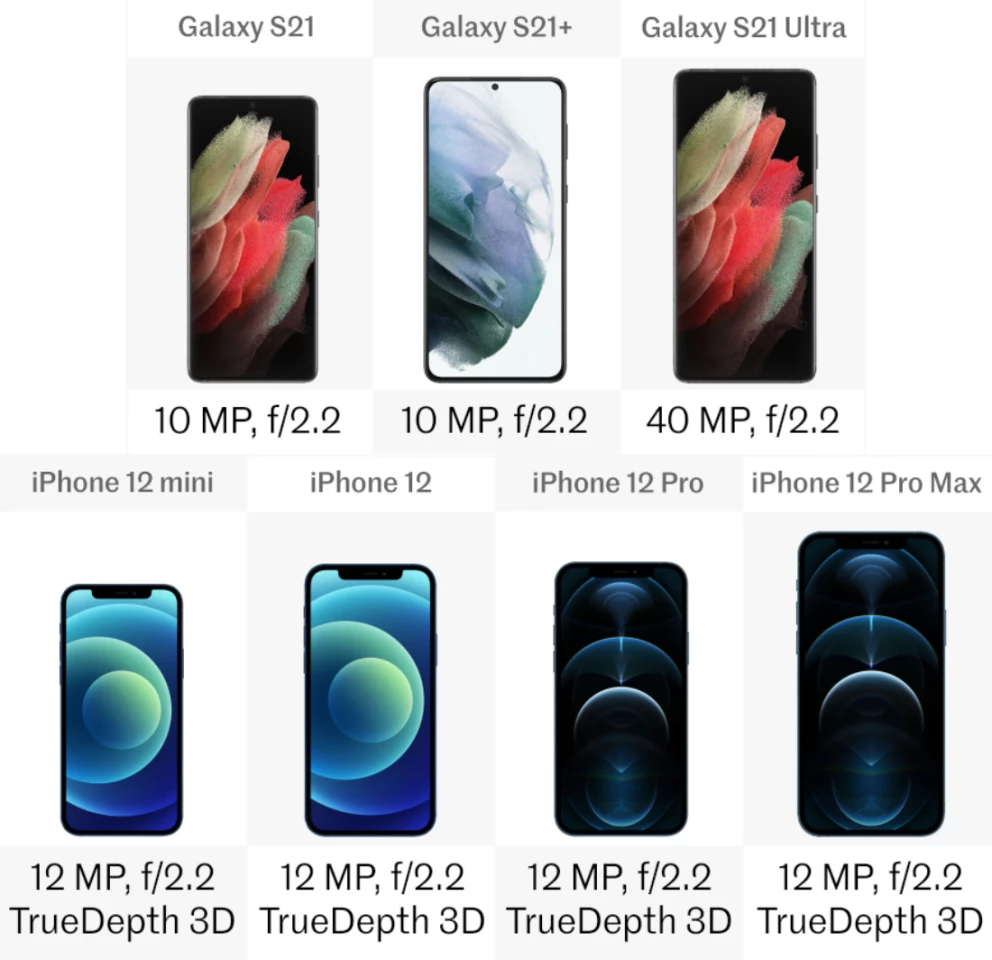
A good selfie is more important than ever, and phone companies are helping you look your best by cramming more and more powerful front-facing cameras into their devices. The baseline of this bunch is 10 megapixels (MP) in the Galaxy S21 and S21+.
The four iPhones are all packing 12 MP, along with a depth-sensing module Apple calls TrueDepth 3D.
The Galaxy S21 Ultra, meanwhile, blows the others out of the water with a 40-MP selfie cam, which will show off every pore and pimple on your face.Rear camera

The days of the single rear camera are long gone – you’re looking at at least two, no matter which of these phones you choose.
The base combo on each is a wide and ultra-wide lens, usually with 12 MP each and varying apertures (the f-numbers). The iPhone 12 Pro and Pro Max, and the Galaxy S21 and S21+, also add a telephoto lens to the mix, with 12 MP on the iPhones and a huge 64 MP on the Galaxies. Not content with just the one, the Galaxy S21 Ultra packs a pair of 10-MP telephoto cameras.Photo modes

Despite the differing camera hardware, all these phones are capable of more or less the same photo modes – they might just be hiding under different names.
All seven phones can shoot photos in high dynamic range (HDR), which lets them capture both bright and dark areas at once without losing detail.
They all have bokeh effects, where the background can be artfully blurred to make the subject pop. Portrait mode is usually where this can be found.
Panoramas are a mainstay of course, aided by the ultra-wide cameras on each phone. Users can take several photos in a row and stitch them together to create one big landscape.
Night mode takes longer-exposure shots to help light up dark scenes, with impressive results.
All seven phones have augmented reality capabilities too, where virtual images and characters are overlaid on the real world. AR tech can be used for things like catching Pokémon in the park, putting bunny ears on your selfies, or sizing up how Ikea furniture would fit in your living room.
All of these phones can zoom in and out to different degrees, with telephoto lenses helping for the former and ultra-wide lenses the latter. The most impressive is the Galaxy S21 Ultra, which can zoom up to 10x optical (using the physical lens) and an astonishing 100x digitally.
The other galaxy S21 models are next in line, with a decent 3x hybrid optical zoom and impressive 30x digital. The most powerful iPhone can manage 2.5x optical and 12x digital zoom, followed closely by the iPhone 12 Pro at 2x optical and 10x digital. And finally, the iPhone 12 and 12 mini can use their ultra-wide lenses to zoom out 2x optically, and 5x in digitally.
There are a few differences between the Android and Apple phones though. The iPhones have a function called Deep Fusion, an image processing system that can apparently capture more detail and texture in images, while reducing visual noise in lower light. Samsung’s Selfie mode is claimed to do the same kind of things.
Samsung has a feature it calls Scene Optimizer, which can apparently detect what’s in the frame and automatically adjust certain settings, such as exposure and contrast. The modes include faces, people, animals, food, sunrises and sunset, greenery, cities, and flowers.
Also on the Galaxies, Single Take is designed to capture the best shot of a fast-moving subject. To do so, the camera records a short video, then pulls out the best stills.Video modes

All of these phones can shoot video in Full HD and 4K resolutions, at up to 60 fps. Apple gives iPhone owners a tad more frame rate freedom, also allowing 30 fps in FHD and 24 or 30 fps in 4K.
The Galaxies go even further and allow users to shoot video in an astonishing 8K. With no less than four times the resolution of 4K, and 16 times FHD, that’s an impressive tick on the back of the box, but there’s an important caveat – you probably don’t have anywhere to watch them. The phone screen itself can’t play back those videos at full resolution, and very few people have 8K TVs or monitors yet. So unless you’re a super early adopter, there’s not a whole lot of use for this yet. You could argue it’s future-proofing, but let’s be honest: you’ll probably buy a new phone in a year or two anyway.
Slow motion video is available on all of these phones, slowing time down to 240 fps. The iPhones have the not-quite-as-slow option of 120 fps too, while the Galaxies can bring time to an absolute crawl at 960 fps.
Going the other way, they can all shoot time lapse videos too – 4K resolution at 30 fps for the Galaxies, while Apple doesn’t specify its specs.
The videos are kept steady using both optical and electronic image stabilization (OIS/EIS).
The Galaxy range can capture high dynamic range in the HDR10+ standard. Apple however uses Dolby Vision, which supports dynamic metadata just like HDR10+, and which seems to be winning the standard war in terms of support on a greater number of TVs and streaming services. It's a grading technique that’s usually applied to films during post-production and, most impressively, the iPhones can do it in real-time, a feat that even professional movie cameras can’t do, let alone other phones.Biometrics

All seven phones can be unlocked with a quick scan of the user’s face. The Galaxies also have an ultrasonic fingerprint sensor, embedded in the lower part of the screen.Water resistance

Every phone on this list has an ingress rating of IP68. Officially that means they’re dustproof, and waterproof to a depth of 1.5 m (4.9 ft) in fresh water for up to 30 minutes. Apple goes even further and claims that the iPhone 12 series can actually dive to 6 m (20 ft) for 30 minutes, which is far more than other companies are willing to claim. Independent tests seem to verify the claim.
Of course, we wouldn’t recommend taking it swimming with you every day, but it’s nice to know that if you do accidentally drop it in a pool, you’ve got a leisurely half hour to fish it out.Built-in storage

The iPhone 12 and 12 mini start the race for built-in storage at 64 GB, which is probably plenty for some people. The baseline though is 128 GB, which is available on all seven phones, as is 256 GB.
Particularly heavy users, meanwhile, might want to go for the Galaxy S21 Ultra or the iPhone 12 Pro or Pro Max, which offer a generous 512 GB.
That said, storage capacity is a major point of difference on price, so be prepared to fork over an extra US$50 to $100 (or more) for each step up.MicroSD

One of the long-standing advantages to having a Galaxy was the ability to expand storage with a MicroSD card. Sadly, that’s no longer the case – Samsung has now dropped the slot from this year’s flagships for the first time.
Like the 3.5-mm headphone jack before it, we may be seeing the beginning of the end for the MicroSD card slot – another victim of the industry’s tendency to copy whatever Apple does, for better or worse.Battery

In pure numbers, the battery capacities for this batch of phones runs in order through all four iPhones, then the three Galaxies. In fact, the meatiest Galaxy has more than double the capacity of the mini-est iPhone.
That said, numbers don’t tell the whole story, and Apple’s tight control over its hardware and software ecosystem means it may be able to streamline processes.
In practice, it doesn’t matter too much, and you should be able to get more than a day’s solid use out of all of these phones.Fast charging

All seven of these phones can be fast charged, but the plugs themselves are sold separately. The iPhones can use 18-W chargers, while Samsung sells 25-W chargers and the S21 Ultra supports a “superfast” 45-W charger.Wireless charging

Wireless charging is also available across the board, but again you’ll need to buy the charger separately.
Samsung also offers Fast Wireless Charging, and a feature called Wireless PowerShare, which lets it charge other devices by placing them on top of the phone.5G

New phones are increasingly tapping into 5G, as these faster cellular networks roll out to more places worldwide. Case in point – every one of this bunch can make use of it.
As mentioned earlier though, there are two types of 5G tech: mmWave and sub6. Basically speaking, mmWave is faster but not available in as many areas yet, while sub6 is easier to find but not really much faster than 4G.
Both companies’ phones have versions that work on each technology, and which one you get will depend on your carrier and location.Ports

You’ll only find one port on the bottom of each of these phones – an industry standard USB-C on the Galaxies, and Apple’s proprietary Lightning port on the iPhones. These are used both to charge the devices and plug in headphones.Operating system

Each set of phones is running on the latest version of its respective operating system: Android 11 for the Galaxies, and iOS 14 for the iPhones.Assistant

Likewise, each company’s voice assistant – Samsung’s Bixby and Apple’s Siri – can be found on their home phones.Release date

The iPhone 12 and 12 Pro were the first out of the gate, releasing back in October 2020. The higher and lower end of the range followed a few weeks later in November.
The three Galaxy S21 phones landed in late January 2021.Price (US$)

There’s a good spread of prices here, with some decent choices available for well under a grand. Although, of course, the premium phones also go well north of that too, if you’ve got money to burn.
Unsurprisingly, the iPhone 12 mini is the cheapest of the bunch, starting at US$699 for the 64 GB model, or you can double the storage for an extra 50 bucks. Throw in another $100 and you’ve got a roomy 256 GB.
After that, prices seem more or less in-step between the two companies. The Galaxy S21 and iPhone 12 prices line up, although at each tier you’re getting double the storage in the Galaxies.
The Galaxy S21+ and iPhone 12 Pro are priced the same for 128 GB, while the 256 GB Galaxy S21+ is $50 cheaper than its same-sized rival.
The iPhone 12 Pro Max is actually cheaper than the Galaxy S21 Ultra – the 128 GB model is $100 cheaper than the equivalent Galaxy, and the 256 GB model $50 cheaper. For the 512 GB model, the Galaxy just pips the iPhone by 20 bucks.
So with all that in mind – are you on Team iPhone or Galaxy? And which model are you choosing? Or if you want to see what your other options are, check out more of our phone comparisons.


